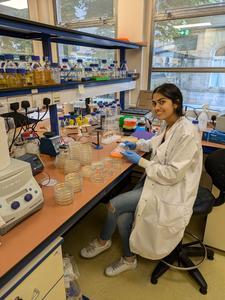Meet Harry Smith Vacation Studentship recipient: Janvi Gianchandani Baxani
Posted on October 22, 2024 by Microbiology Society
The Society offers a limited number of Vacation Studentships to enable undergraduates to work on microbiological research projects during their summer vacation. The scheme also gives early- and mid-career scientists the opportunity to gain supervision experience.
Meet the Vacation Studentships receipients and learn more about their journey.

What is your name and institution?
My name is Janvi Gianchandani Baxani, I am currently pursuing my bachelor’s degree in microbiology at Trinity College Dublin.
What inspired you to go into this field of work?
The Vacation Studentships grabbed my attention due to the encouragement it offers to undergraduate students to work on a research project, including the flexibility to develop the project if possible. I am interested in medical microbiology research, and as an undergraduate student, this studentship has given me the opportunity to experience a research environment at an early stage.
In short, I applied for the Studentship for its generous support of my research aspirations.
How did you feel when you found out your application was successful?
I was absolutely thrilled when I found out that my application was successful. This studentship would take me one step closer to my goal of contributing to real-world research. It will also prepare me for forthcoming projects and challenges, such as the one I anticipate in my final year. I was really grateful and excited and I look forward to the opportunity to follow my passion for microbiology.
How would you go about explaining your research to someone who may not understand science?
For my summer research project, the primary objective was to modify an essential gene encoding the RNaseE enzyme in Acinetobacter baumannii AB5075, a multidrug-resistant pathogen. Instead of completely deleting this gene and compromising the bacterium’s viability, the goal was to make temperature-sensitive conditional mutants of the gene, resulting in different RNaseE mutants. With this approach, I aimed to impair RNaseE function (which normally degrades RNA) under different temperatures and explore how RNA metabolism could be controlled and studied.
To achieve this, I used PCR (Polymerase Chain Reaction) to amplify and combine the mutant version of the gene and an antibiotic resistance cassette into a linear product for insertion into the bacterium. A. baumannii is naturally competent, i.e., it can naturally take up DNA from the environment in a process called transformation and then insert it into its genome at regions of sequence similarity by a process called homologous recombination. Thus, I relied on natural transformation to insert the linear product, encoding the mutant RnaseE gene-antibiotic resistance cassette, into the genome. I selected the insertions using an antibiotic that the antibiotic resistance cassette encodes resistance for, thus killing all the other untransformed bacteria.
After I obtained these modified bacteria, or transformants, I tested their growth at different temperatures, i.e., permissive (30 °C) and non-permissive (42 °C) to confirm the correct insertion of the linear product and replacement of the original gene by the mutant gene by observing an absence of growth due to the inactivation of RNaseE at the higher temperature.
However, even after screening more than two thousand transformants, I encountered many false positives suggesting that the product might have inserted elsewhere in the genome. Working with the RNaseE enzyme proved to be tricky, as these kinds of mutations are not achieved easily since the enzyme is essential. This provided me with a valuable sense of the enzyme's essentiality due to its role in RNA metabolism.
What have you learnt from your experience?
During my summer internship, I learnt the application of gene manipulation methods to modify the bacterial genome. I gained hands-on experience working with the pathogen Acinetobacter baumannii – which improved my understanding of microbial genetics, microbial pathogenesis and RNA metabolism.
I also learnt the importance of precision and meticulous attention to detail when performing experiments using laboratory protocols, to ensure optimal conditions are maintained in each technique to minimise errors. Overall, this experience has expanded my knowledge in microbiology and has inspired me to follow a professional path in this area.
How do you think this vacation will help your career progression?
This vacation studentship will greatly contribute to my career progression. It has made me more observant of every aspect of lab workflows and built my confidence in performing techniques that are new to me. I will surely approach future projects and opportunities with an open mind since I have already dealt with trial-and-error scenarios in the lab. Since I had to present my work to the lab at the end of the internship, this experience also trained me to think and communicate more proficiently like a researcher. In the short term, this will help me with my final year project and, in the long term, pursue a future career in microbiology.
Why is support, such as this grant provided by the Microbiology Society, so important?
This financial support is important because, firstly, it gave me the chance to conduct my research with access to all the necessary consumables, which is essential for producing high-quality work. It has allowed me to focus entirely on my project without the financial burden. It has also given me a sense of understanding of the research world, and the challenges in funding one’s own research and performing experiments with the obtained grant. This grant and the research experience teach young researchers like me to optimise resources and effectively follow through on their work from start to end. An experience that cannot be obtained from coursework alone.
